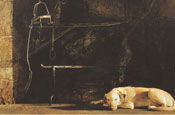
Ides of March
Andrew Wyeth’s ‘Ides of March’
In many of Andrew Wyeth’s artwork, there exists a clash, often a duality of images and emotions. This sentiment is blatantly apparent in his piece titled Ides of March.
Wyeth is a master at blending the smooth and gentle with the harsh and jagged. With regard to his paintings, he once stated that “...something waits beneath it [the painting], the whole story doesn’t show.” This can be said for the majority of his pieces. They seem to suggest that something is lurking behind the scene, as if you have walked into a story having missed the beginning.